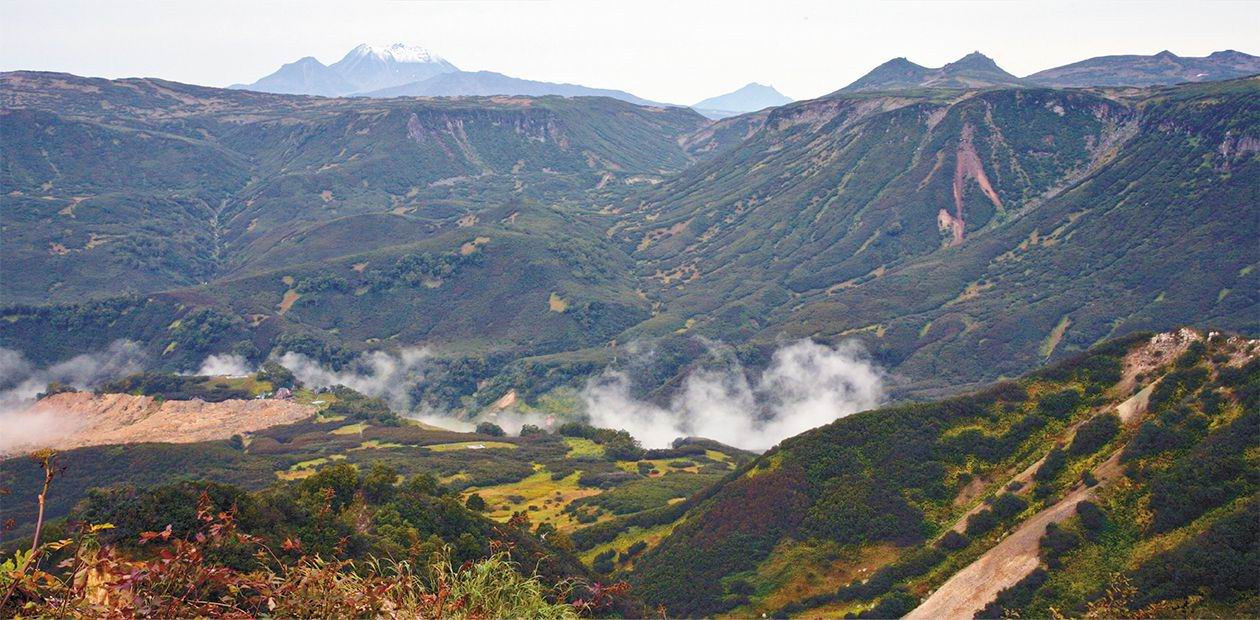Report From the Death Valley
The Valley of Death… When you enter this "wicked" name in any search engine of the World Wide Web, you will receive information both on a hot and lifeless desert at the border of California and Nevada, and on mass burial grounds of Russian soldiers near Leningrad, and even on the uranium mines of Yakutia, where thousands of prisoners found their death…
Also you will find a scant description of the amazing valley in the Kronotsky reserve, located in Kamchatka, rumored to conceal a threat to all living things on Earth. In the fall of 2008, an expedition of "microbe hunters" consisting of researchers from the Siberian Branch of the Russian Academy of Sciences (SB RAS) and specialists from Moscow went there. And today, together with these scientists, our readers have a rare chance to make a safe journey to one of the legendary and little-studied corners of Earth
On a rainy September morning we arrived at Petropavlovsk-Kamchatsky. But as early as the next day we were cheered up by an almost clear sky: the weather was good for flying and we were full of hope we would get to the Geyser Valley on that very day.
And there we go: rivers are meandering under us like slick snakes, steep volcano screes are moving swiftly past, and clouds are swooping straight at us. Under the clouds, there appear red colored tablelands, all covered with bushes—the bears roaming there squat and run away as soon as they hear the helicopter roar.
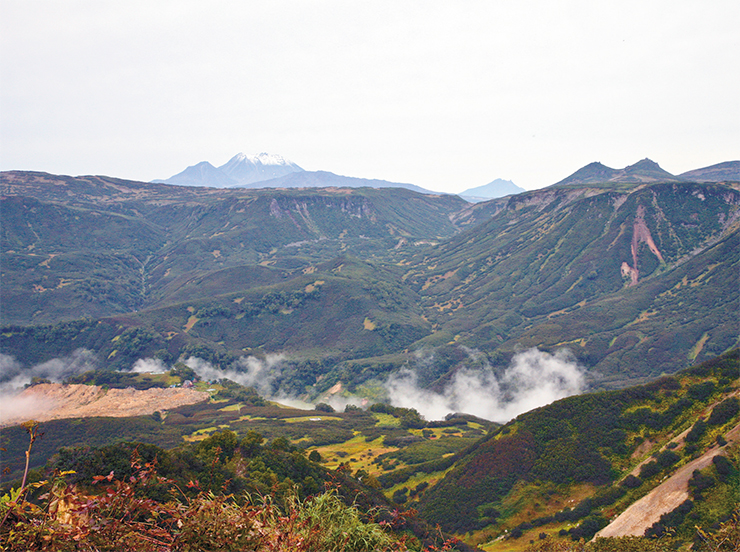
...And now we are flying over the Geyser Valley, above familiar blue camp houses, which have miraculously survived the earthquake in 2007. The camp has not completely recuperated from the damage yet: there is no hot water, showers are disabled, and some stagnant smell still persists in the hall. But this is not important: there is a roof and a kitchen, and the sun is shining—what else is needed for happiness? And ahead lies not just a tourist attraction, but the legendary Death Valley.
Along the Bear Paths
The road from the main camp located in the Geyser Valley to the Death Valley is short—an easy one-day trip. But the reserve has strict rules which are obeyed meticulously. The Deputy Directory of the reserve, I. T Shpilenok, who had flown to the camp, examined us to make sure that our team was well prepared, and gave detailed instructions. It went without saying that we were not allowed to go on this trip alone: three armed employees of the reserve—cheerful young guys, romantics and adventurers—kept us company.
…And so came the long-awaited morning. We ate our breakfast deliberately—in Kamchatka nobody sets off early: the grass is all wet from dew and fog, and you can get wet to the bone immediately. Our small expedition plunged into bushes, following bear-trodden paths. We were traveling light—the inspectors carried just carbines and army bags, and we had cameras and light backpacks. A grass knoll opened in front of us when, after a few hundred meters, the bushes ended. Having crossed a small brook with a rocky bed, we started walking upstream the river Geysernaya.
The Geysernaya runs almost all of its way along the bottom of a deep canyon. Its steep banks, 100—300 meters in height, are formed from soft rock, and it is impossible to climb up or down them without special equipment. We were heading for the uppermost part of the canyon, and then for the plateau—to the Kikhpinych volcano, where the Death Valley is located. Fortunately, the climb along the brook was not so difficult.
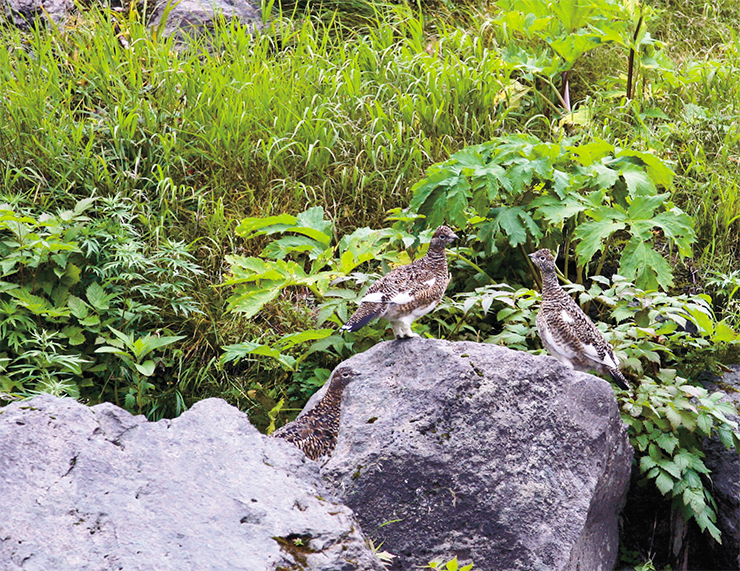
…We came to a slope overgrown with mountain pines, and then to the fields covered with some red grass, red mountain cranberries and black crowberries. We were walking at easy pace, picking ripe berries by handfuls on the way. Snow covered the mountains, and colorful volcanoes with fantastically deformed summits loomed far away.
After we broke camp at the most beautiful site on the multi-color grass, our spirits became even more elevated. The sun, though not so bright, was shining. We walked quickly along the trodden bear paths littered with bear droppings, consisting almost entirely of half digested berries. Soon we found ourselves at the foot of the yellow-brown Kikhpinych volcano, barren of plant life. The level grounds were covered with stones, more or less rounded; the streams were strewn with huge lumps of rock and shards of black volcanic glass; and towering above the slopes of the ravines were dingy snow piles.
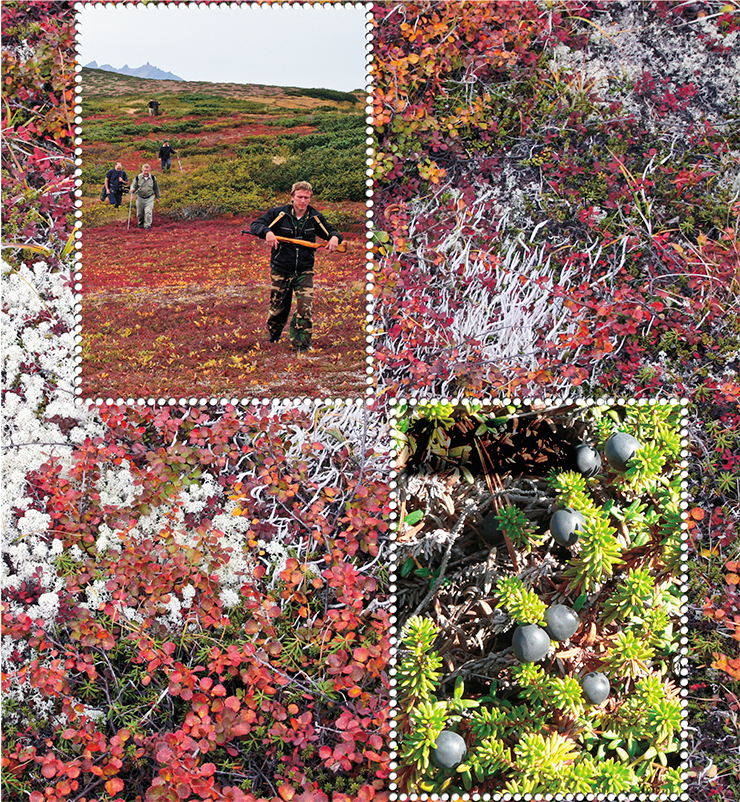
Jumping from one slightly rounded basalt lump to another along the blind creek bed, we reached our destination—the western slope of the volcano. There, by the junction of three streams running along gorges down the volcano slope, stood a small house. It was built some time ago by the explorers of these parts who had flown in here by helicopters. An employee of the reserve, a famous photographer and specialist on bears who knew well their temper and never feared them, had often stayed in this house. And yet, several years ago, he got killed by a bear. Maybe in his chase for a lucky shot he came too close to the animal rested in the bushes…
From the observation site located on the roof of the house opens an amazing view on the neighboring mountains; and near the house, between low bushes of mountain pine, everything is covered with large overripe crowberries, whose taste is especially sweet in these parts. As we were grazing on the berry glades, we saw a family of bears doing the same thing some four hundred meters from us.
In the Land of Hades
The Death Valley itself was below us, in the canyon—where the streams were running together to form the river Geysernaya. Their banks were quite unusual—lifeless, predominantly yellow and red. The smell coming from the valley brought thoughts about a stuffy chemical storage area…
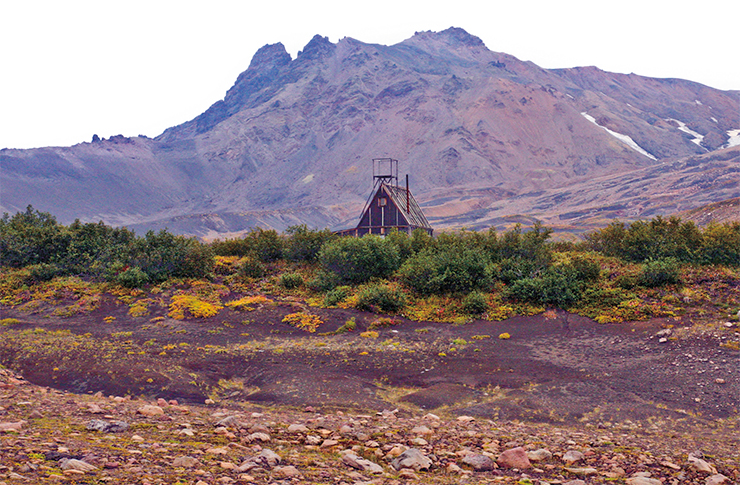
After tea we sat in front of the house and shared our knowledge regarding the Death Valley. As is known, fumaroles (small holes through which volcanic gas is emitted) exhale there, on the river banks, and this is why hydrogen sulphide, carbon dioxide, and probably hydrogen cyanide accumulate in the canyon in windless weather.
The mixture of poisonous gases concentrates at the ground level so it is very dangerous to bend down there. Birds and animals often die there, poisoned by the gas. Researchers, usually arriving by helicopter, take air samples at the bottom of the canyon. They do it wearing gas masks, one of which was hanging inside the house by the stove.
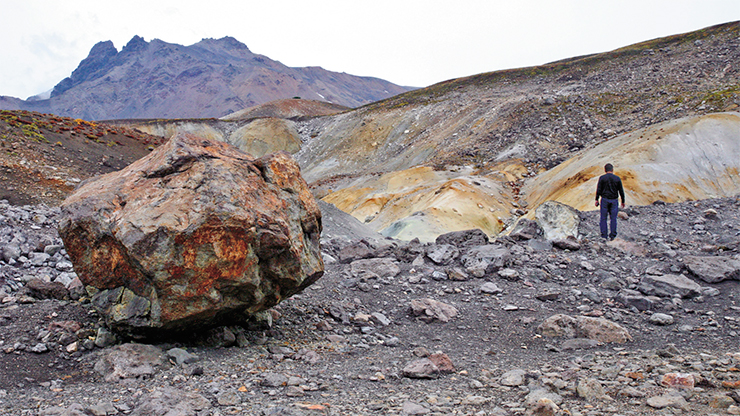
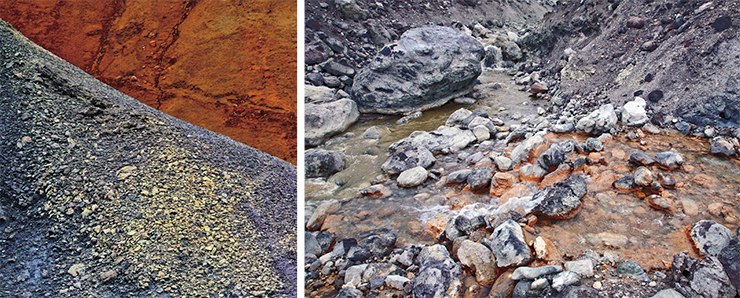
The maximum acceptable concentration of hydrogen sulphide is 0.008 mg/l. When gas concentration reaches 0.02—0.2 mg/l or is higher, symptoms of poisoning of the nervous system, respiratory and digestive organs are reported. The concentration equal to or above 1.2 mg/l leads to a quick death due to anoxia caused by blockage of tissue respiration.
Nevertheless, hydrogen sulphide is not as alien to our organism as you might think. For ages, baths with natural hydrogen sulphide water have been widely used as a complex treatment for some diseases and as a cosmetic means. It has recently been discovered that hydrogen sulphide plays an important physiological function in the organism of mammals as it takes part in blood pressure regulation.
It is formed in the walls of blood vessels with the help of cystathionine gamma lyase ferment. With age, organisms lacking this ferment start to suffer from hypertonia; in this case, very small concentrations of hydrogen sulphide can be used directly to regulate blood pressure.
Next to the stream our sharp-sighted inspectors noticed some dark objects, which did not fit in the local scenery. Without further delay we hit the road: a light breeze was blowing and the danger to get poisoned was smallish.
The slope was steep: some of us were running down the slope, some crawled, clinging to it. The foreign objects happened to be corpses of a bear cub with a pecked side and a big eagle. The cub might have lost his family, fallen down and got poisoned, or the whole bear family may have come to the dangerous place and the small cub gulped surface gases while his husky mother managed to get away. The eagle saw the corpse of the bear cub, started pecking at his trophy and became another victim of the Death Valley.
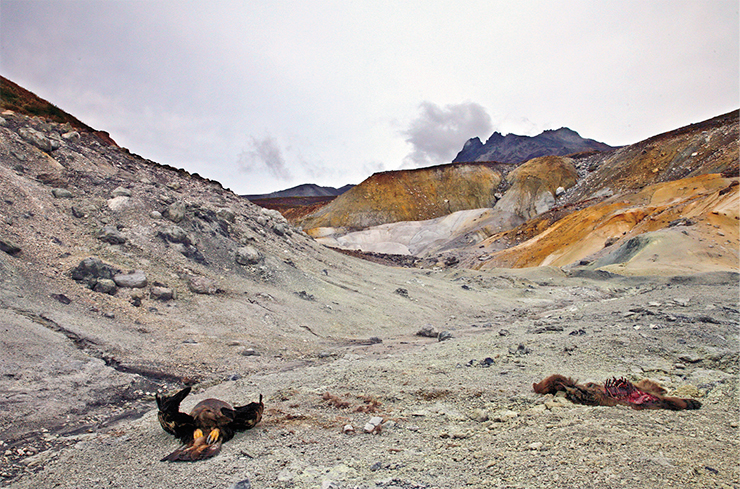
Making photos and describing the surroundings was important but not the main goal of our visit. We were to collect the “most invisible” inhabitants of the Death Valley—microorganisms, known to be the very first inhabitants of our planet.
The Valley of Death is located in a deep canyon, where the three streams—Blue, Yellow, and Transparent—merge.The smell reminds of a chemical laboratory: obviously, gases leak outside through the soft rocks of the banks. The color of the banks is unusual because of elemental sulphur: in some places it is yellow and in others, dim-grey.
Everything looks gloomy, in full conformity with the name of this place
When you are looking at the lower reaches of the Death Valley, it seems that it is completely lifeless because of a higher concentration of specific gases and yellow sulphur crystals… This is really not the place for higher organisms. However, even in these severe parts life does not lose ground: chemolithotrophs—microorganisms which use chemical environment alien to us—live there.
Substrates on which similar microorganisms live in nature are in many ways similar to the main products of volcanic eruptions. We are referring to such components of volcanic (juvenile) gas as hydrogen, hydrogen sulphide, methane, ammonia, etc. This is why, for these microorganisms juvenile gas plays the role of the substrate to sustain life, similarly to the gas generated in the process of anaerobic (airtight) decomposition of dead organics.
Nameless World
…The evening was getting closer and we started preparing for the trip back. Our spirits were high, we felt brave, energetic and full of life. And maybe this so-called volcanic gas was getting to our heads since all of a sudden we started remembering old songs, including the song by Ian Frenkel whose words matched our case perfectly: “The air of Motherland—it is special, you can’t get enough of it”.
And in these high spirits we decided to return home taking another route, straight along the river Geysernaya. After all, the distance to our camp on the straight was almost nothing—six kilometers only.
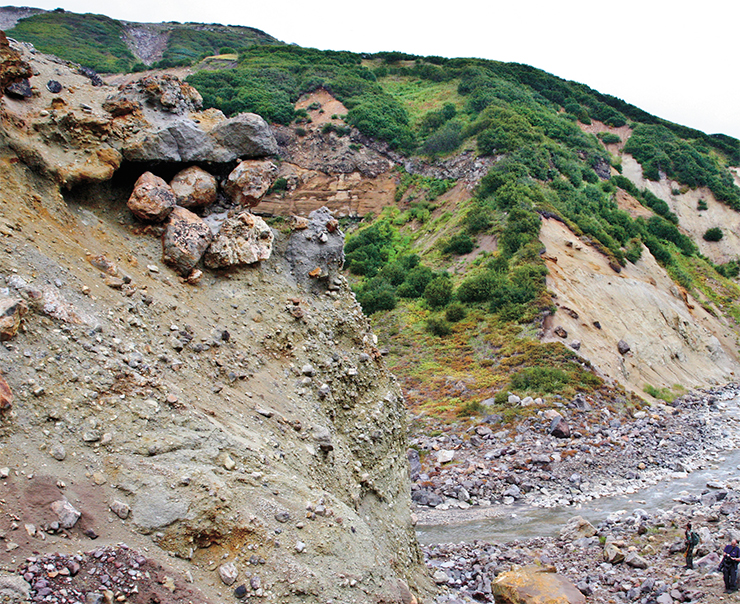
Along the steep bed of one of the tributaries we went down to the river, which, at that time, was yet a rapid stream. Soon we found out that there were no paths along the river—in this wild and barren land even geysers had no names. The river meandered, and it became clear that we would have to walk a much longer distance.
In the Death Valley, poisonous volcanic gas, nascent from small apertures of the river banks covered with sulphur, accumulates near the ground. Its latest victims are a silly bear cub and an eagle attracted by the easy preyAt doubles, the river ran closer to its abrupt banks. At first, we counted the times we crossed the river but quitted after the thirtieth crossing. In the beginning we were able to find places from where we could get over to the other side of the river by jumping on raised stones; later, places where we could wade across the river. After that, we had to walk in the water: the main thing was to keep our footing against the water current—at times, the whitewater was getting waist-high, and the river became really dangerous.
As we were descending lower and lower, the riverbank turned into inaccessible high cliffs whose tops seemed to be decorated with sophisticated towers of ancient fairy-tale castles. Unfortunately, we failed to make pictures of these miracles: the evening twilight came too swiftly upon us, a mist fell, and it started to drizzle.
SMALL EXTREME “ROCKEATERS” The history of science testifies that any chemical compounds generated on Earth will find their own fan from the world of microbes. This is why even the discovery of Antarctic microorganisms using modern antibiotics as their only source of carbon is not so amazing. (Repin et al., 2008).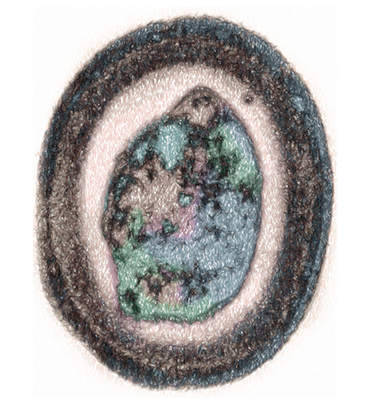 Chemolithotrophs use redox reactions involving inorganic substances as their energy source. For example, we can look at reduction of carbon dioxide to methane, or hydrogen sulphide oxidation (CO2 + H2 → CH4; H2S + O2 → S0). There are numerous groups of bacteria able to oxidize sulphur compounds (hydrogen sulphide, molecular sulphur, etc.), which thrive in the Death Valley in Kamchatka (H2S + O2 → S0; S0 + Н2 → H2SO4).
Chemolithotrophs use redox reactions involving inorganic substances as their energy source. For example, we can look at reduction of carbon dioxide to methane, or hydrogen sulphide oxidation (CO2 + H2 → CH4; H2S + O2 → S0). There are numerous groups of bacteria able to oxidize sulphur compounds (hydrogen sulphide, molecular sulphur, etc.), which thrive in the Death Valley in Kamchatka (H2S + O2 → S0; S0 + Н2 → H2SO4).
Most of these amazing creatures, which do not require solar energy to sustain their life activity (nor energy preserved in organic matter), prefer pretty extreme environments: too hot, too acidic, or lacking in oxygen. It is small wonder that an enormous number of them remain unknown even to microbiologists.
It should be said that today the principles of regular systematics have come to the end of their resources because the classic definition of species can hardly be applied to microorganisms. Modern classification of bacteria relies on the differences in base sequences of genes of their ribosomes (cells’ protein factories).
The collection of the Institute of Chemical Biology and Fundamental Medicine, SB RAS, includes hundreds of strains of microorganisms which, according to “gene systematics”, belong to new taxons. Among them are chemolithotrophs, inhabitants of the extreme Kamchatka environments.
Of special interest to explorers are extremophile microorganisms, which inhabit hot volcanic springs and mud pots.
What is the purpose of these exotic bacteria? The fact is that the efficiency of certain substances transformation (i.e. efficiency of ferments’ work) occurring in regular bacteria and in their “thermopile” brothers can differ dramatically. Today, ferments of thermophile microorganisms are applied in a range of technological areas—for instance, as part of washing detergents and as catalysts for processing various natural products and chemical compounds. Application of microorganisms themselves and their gene systems is expanding.
Well known is the story of triumphal application of the Taq-polymerase ferment obtained from the thermophilic bacterium Thermus aquaticus. DNA-polymerases are used to conduct PCR (polymerase chain reaction), as a result of which multiple copies of the original DNA fragment can be produced.
This method of molecular biology is in common practice. At first, however, its popularization was hindered by polymerase instability at high temperatures, which are required for separation of DNA helix strands. This issue was resolved by application of ferments obtained from thermophilic bacteria.
Using methods of gene engineering, scientists of the Institute of Chemical Biology and Fundamental Medicine SB RAS have constructed, on the basis from collibacillus, bacterial strains—hyperproducers of thermostable ferments (polymerase and ligase), participating in DNA synthesis. The researchers believe that further studies into microorganisms will bring them more surprises
Further downstream, multicolored pulsing bubbling springs started to appear on the river banks; thermal fields were smoking in ravines’ offshoots. But we were in no mood to gaze at the beauty around us: stumbling on the rocks and sinking into pits hidden in thick grass, we hurried to get down and paid little attention to the rapid stream.
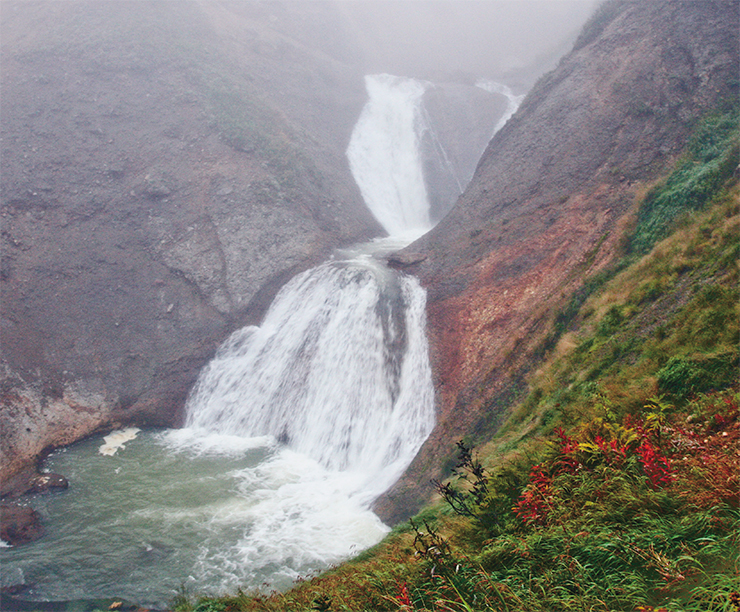
In half-light we reached the most beautiful place on the river with two waterfalls next to each other, and geyser jets sprouting at an angle from the sheer cliffs above them. The right bank was sheer, around a hundred meters in height, and completely inaccessible. We took the left bank; it was also bluffy, and had a very dangerous, wet and unsettled rockslide, whose lower part disappeared in waterfalls.
What were we to do? Below was a roaring waterfall, overhead was a sheer cliff. One of our brave inspectors, equipped with mountaineering boots and sharp pointed sticks, went ahead. We followed, clinging to the crumbling slope with the sharp points of our sticks…
After that, nothing could scare us. The uninterested pale moon was watching through the fog how a group of wet travelers was sliding on the grass and rocks, making their way across the fragile shell of a thermal field, crawling on all fours on the makeshift bridge over the rapid river, jumping over boiling pits, and climbing up a steep slope, showered by geyser jets…
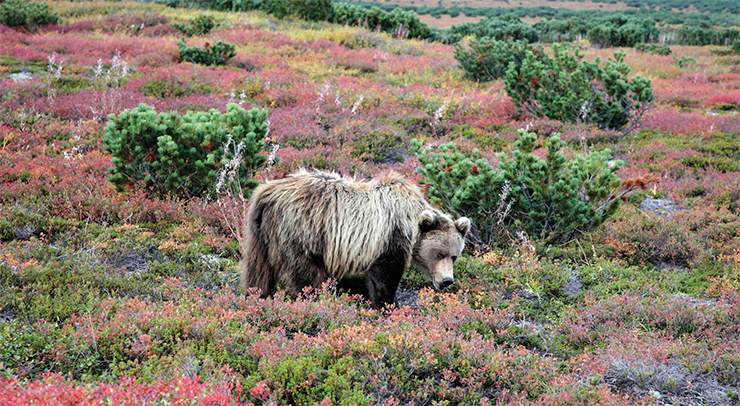
It had grown completely dark when our wet, dirty company stumbled into the house located in the reserve camp—our trip to the Death Valley ended smoothly.
Our losses were negligible: one broken photo camera, several injured shins and a common cold, which some of our travel companions managed to catch. And the next morning only dirty clothes, bottles, test-tubes with samples, and pictures in our cameras reminded us about what we had survived. Our yearning for adventure was satisfied. But for how long?
References
Belousov V. I. Geologiya gidrotermalnyh polei v oblastiah sovremennogo vulkanizma(Geology of Hydrothermal Fields in the Spheres of Modern Volcanism).—Moscow: Nauka, 1978.
Vlassov V. V. Fontany zaterianogo mira (The Fountains of the Lost World) // Science First Hand. 2007. Issue # 1. P. 118—123.
Repin V. Ye., Deineka Ye. V., Simonov A. N., Pestunova O. P., Kolchanov N. A., Vlassov V. V., Prokopkin I. G. Puteshestviye v goriachuyu tochku (Travelling to the Hot Spot) // Science First Hand. 2007. Issue # 1. P. 98—117.
Repin V. Ye., Vlassov V. V. Puteshstiye v nievidimyi mir (A Trip to the Invisible World) // Science First Hand. 2007. Issue # 4. P. 56—69.
Photos used in the present publication are from the archive of V. Vlassov


